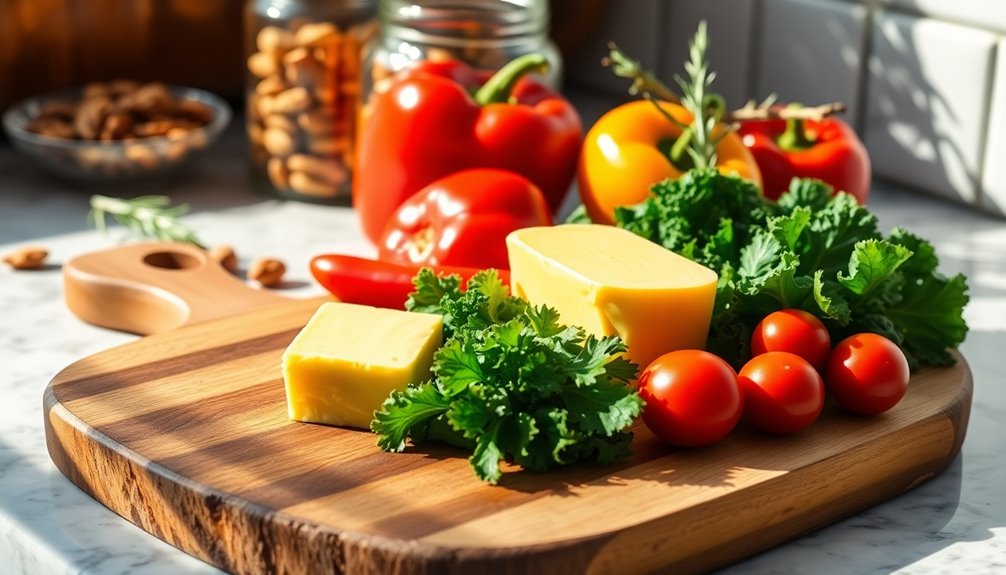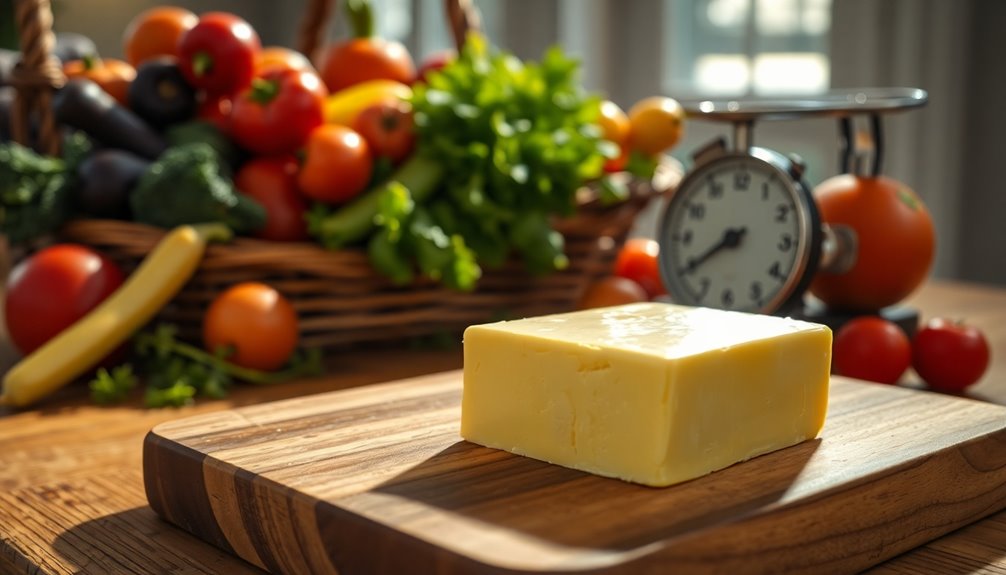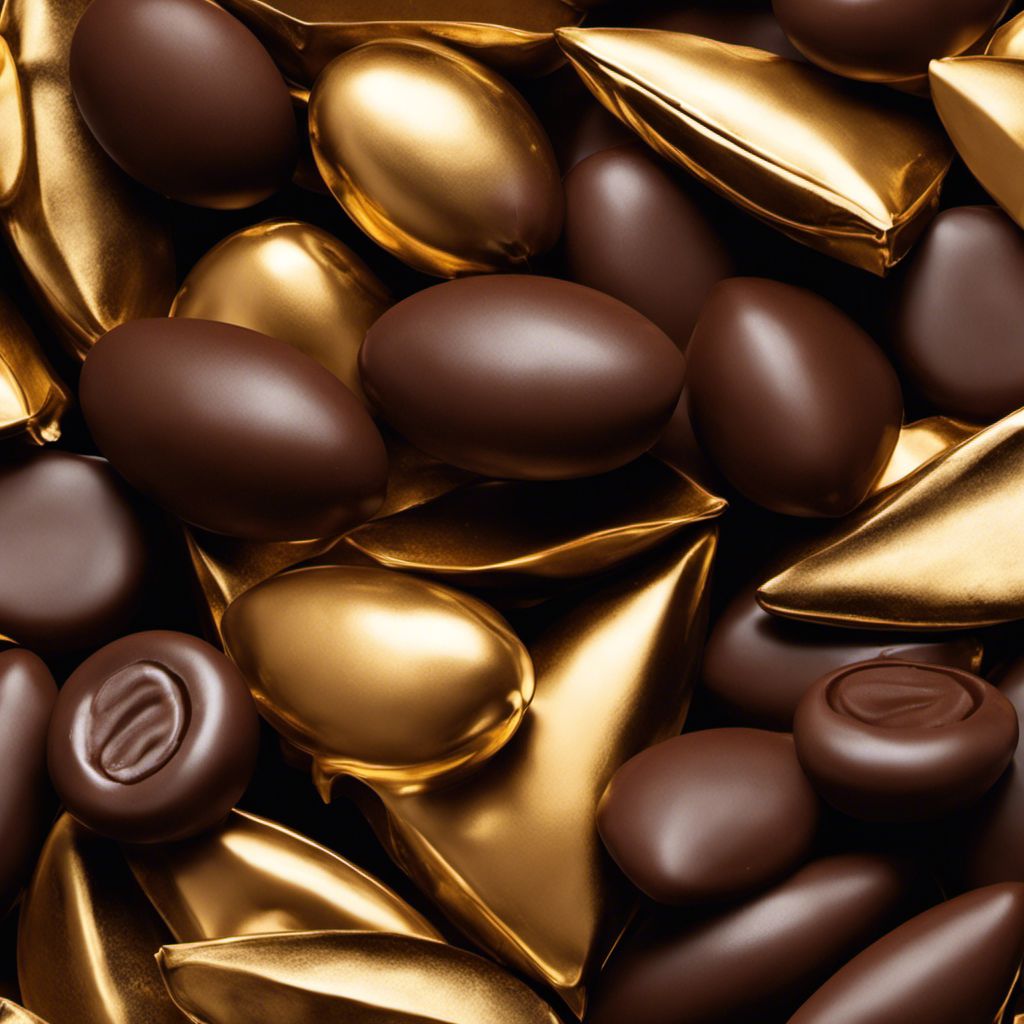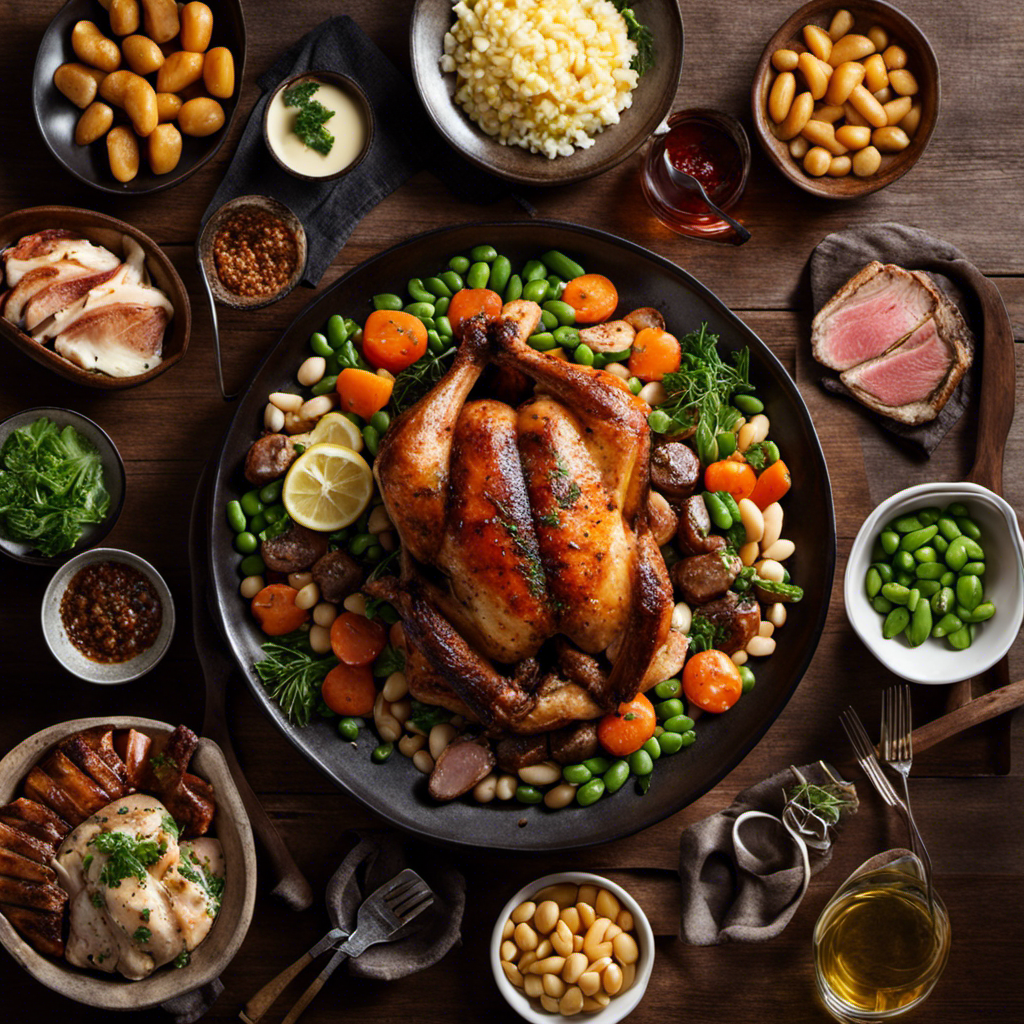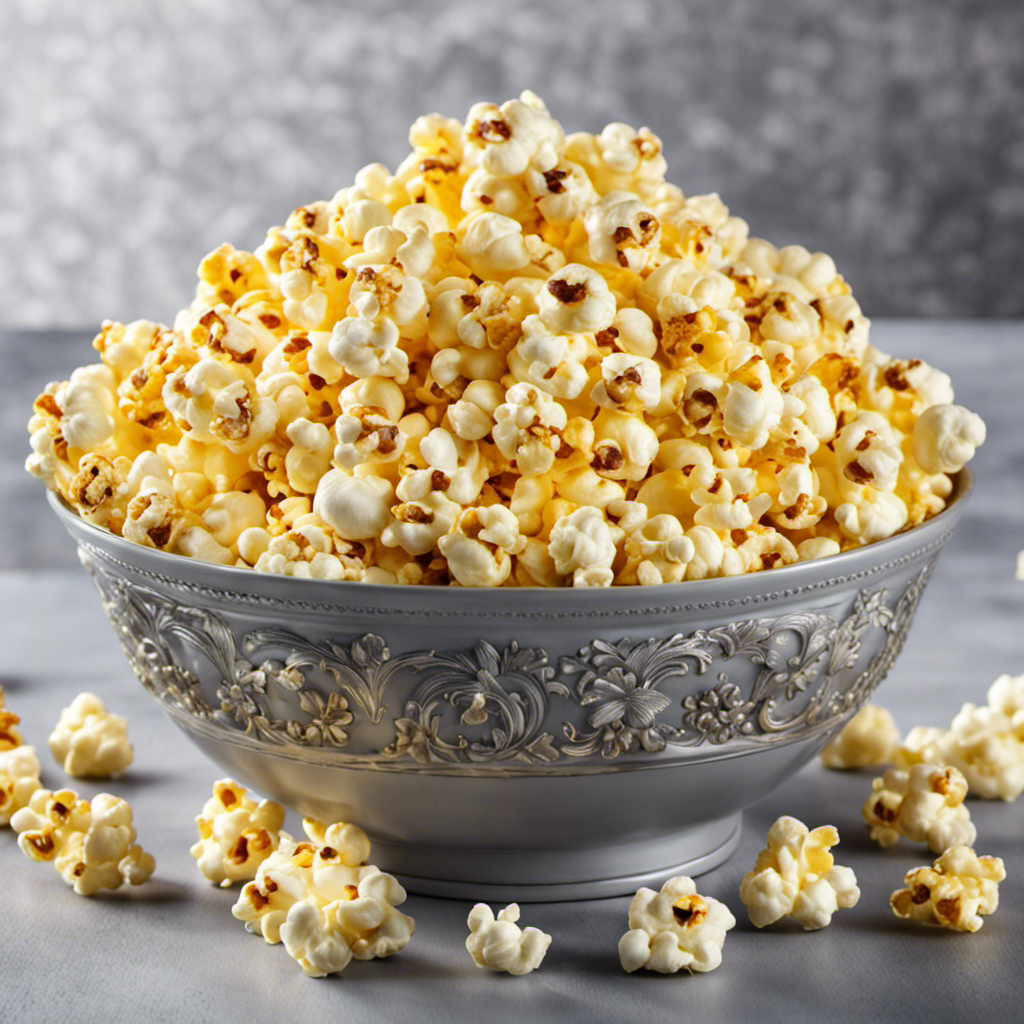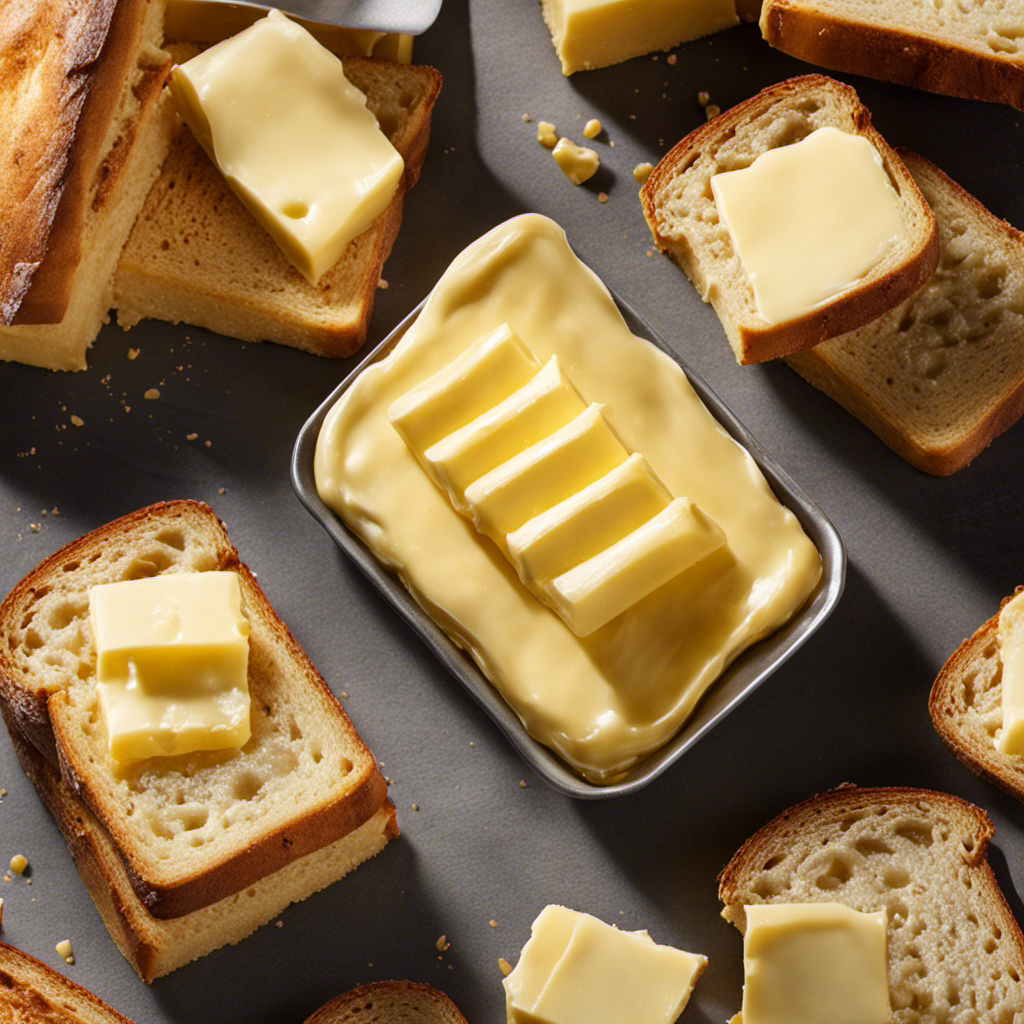You can include butter in your Paleo diet if you tolerate dairy, but moderation is key. Opt for high-quality, grass-fed butter to maximize nutritional benefits, as it's rich in vitamins A, D, and E. Be mindful of your body's reactions, and limit your intake to one or two thumb-sized portions per meal. If dairy isn't for you, consider ghee or other Paleo-friendly substitutes like coconut oil or avocado. Balancing your butter consumption with nutrient-dense foods will enhance your diet. Keep exploring to discover more about making the most of fats in your Paleo lifestyle!
Key Takeaways
- Butter can be included in the Paleo diet for those who tolerate dairy, but moderation is crucial.
- High-quality grass-fed butter offers better nutritional benefits, including omega-3 fatty acids and CLA.
- Ghee is a suitable alternative, being lactose-free and richer in fat-soluble vitamins.
- Excessive butter consumption can complicate weight management due to its high calorie content.
- Balance butter intake with nutrient-dense foods to ensure a diverse and healthy Paleo meal plan.
Is Butter Paleo-Friendly?
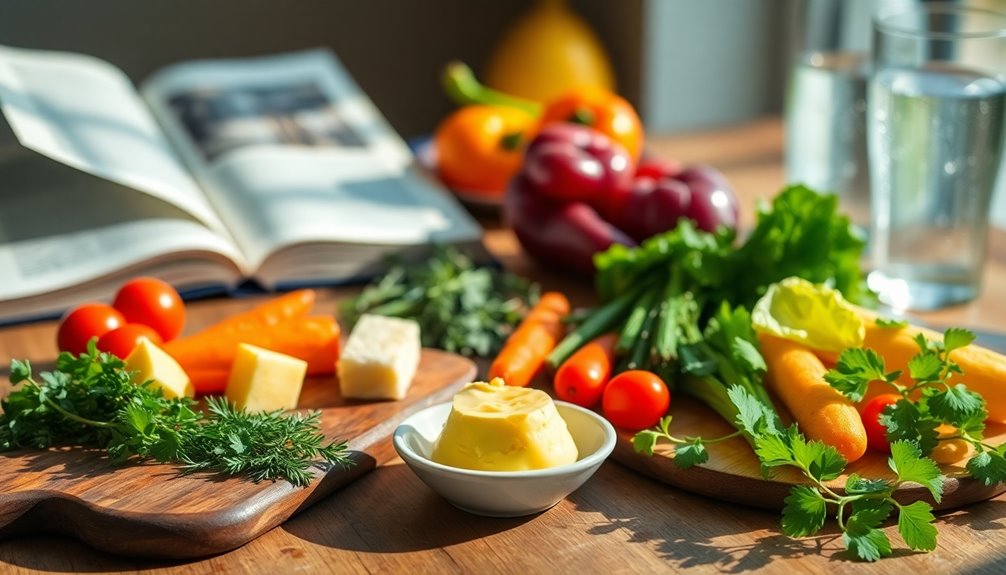
When it comes to the question of whether butter is Paleo-friendly, opinions among enthusiasts can vary widely. The Paleo diet emphasizes whole, unprocessed foods that our ancestors consumed, steering clear of processed items, grains, and dairy.
Butter, being a dairy product, raises eyebrows among strict adherents. Some experts allow it in moderation for those who tolerate dairy, while others argue it contradicts the core principles of the diet. It is important to consider that fat serves as the primary energy source in the Paleo diet, which can provide a rationale for including butter. Additionally, many cultures have historically used butter in cooking, highlighting its long-standing culinary importance. Research indicates that healthy fats can play a crucial role in overall well-being, making butter a potentially beneficial addition for some. Furthermore, moderate consumption of saturated fats has been shown to support heart health in some studies. Butter's nutritional profile, which includes essential vitamins, can further enhance its appeal as a fat source.
Butter contains about 82% fat, primarily saturated fat and cholesterol, which can be concerning for some. However, from a Paleo perspective, these components aren't deemed harmful.
It's crucial to remember that butter has virtually no carbohydrates or dietary fiber, making it a source of healthy fats and essential vitamins.
If you're considering butter on your Paleo journey, think about your individual health goals and dairy tolerance. If you can handle dairy without issues, you might choose to include butter in your meals.
Ultimately, the decision comes down to your personal approach to the Paleo diet and how strictly you want to adhere to its guidelines.
Ghee as a Suitable Alternative
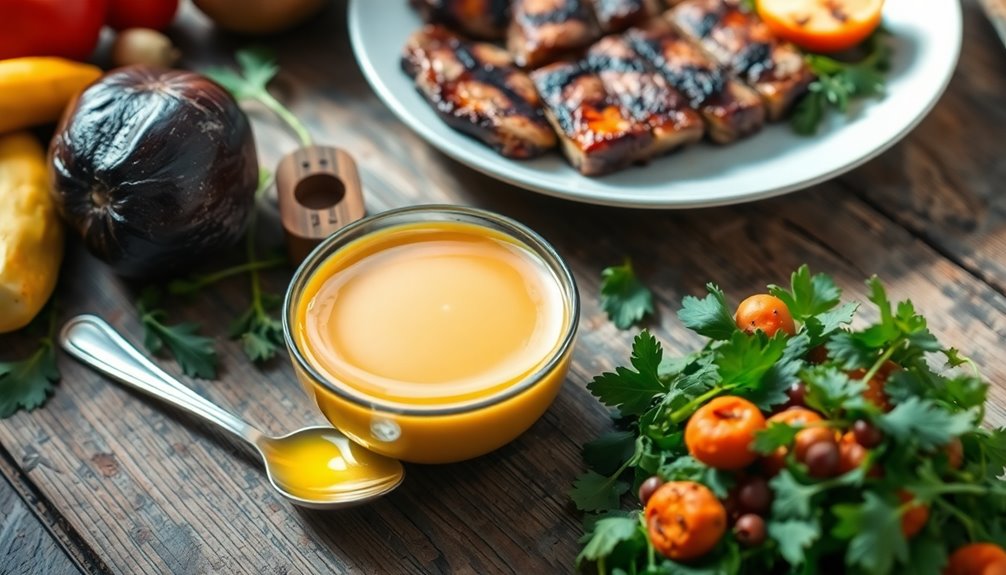
For those navigating the Paleo diet and looking for a viable alternative to butter, ghee emerges as an excellent choice. Ghee is lactose and casein-free, making it a safe option if you have dairy allergies or lactose intolerance. The process of making ghee involves boiling, which removes milk solids that contain these allergenic components, allowing you to enjoy a buttery flavor without the negative side effects. Additionally, ghee is produced through a process that emphasizes energy-efficient technology, ensuring that it retains its valuable nutrients during cooking. Research shows that turmeric's anti-inflammatory properties can further enhance the health benefits of your meals when combined with ghee. Furthermore, it is essential to store essential oils properly to maintain their potency, just as ghee should be stored in a cool, dark place to preserve its nutritional qualities. Chia seeds, which are also rich in omega-3 fatty acids, can complement your diet alongside ghee.
In addition to being allergen-friendly, ghee boasts impressive nutritional benefits. It's rich in vitamins A, D, E, and K, with vitamin E offering antioxidant properties that help protect against various health issues. Ghee also contains omega-3 fatty acids and conjugated linoleic acid, which are beneficial for heart health and reducing gut inflammation. However, it is important to remember that nutritional data provided is for informational use only and should be consulted with a healthcare provider.
Another advantage of ghee is its high smoke point, making it perfect for high-heat cooking methods like baking, roasting, grilling, and stir-frying. This means you can use ghee without worrying about it burning and losing its nutritional value.
Comparing Nutritional Profiles
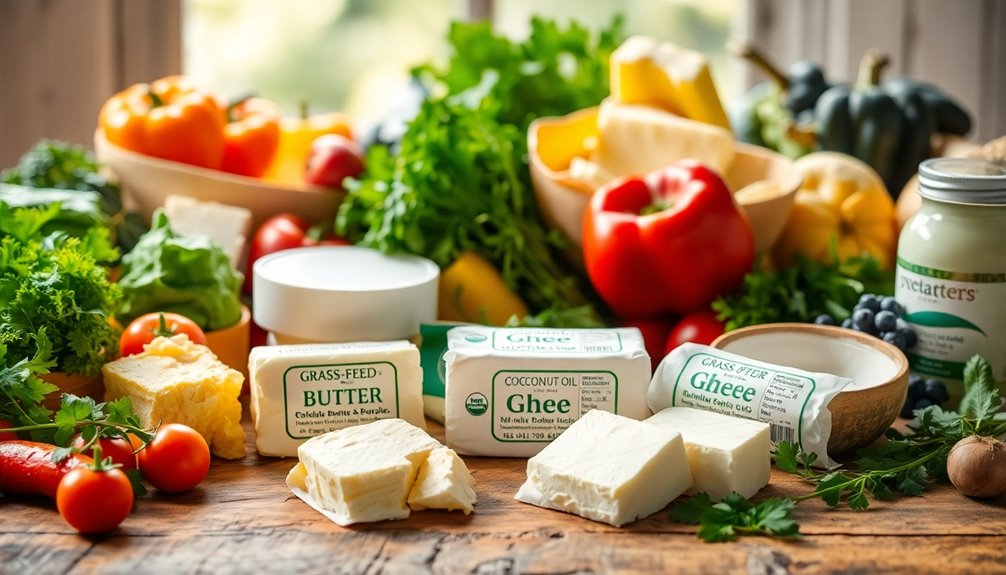
Comparing the nutritional profiles of butter and ghee reveals distinct differences that can impact your health choices.
Butter contains about 102 calories and 12 grams of total fat per tablespoon, with a significant portion being saturated fat. Specifically, you'll find 7 grams of saturated fat and 31 milligrams of cholesterol in each serving. While butter does provide beneficial compounds like Conjugated Linoleic Acid (CLA) and butyrate, it also poses potential health risks due to its high saturated fat content. Additionally, butter is composed of about 80% milk fat, which contributes to its rich texture and flavor. Air purifiers can help improve respiratory health, making it essential to consider overall wellness when choosing dietary fats. For those managing their weight, selecting lower calorie options like best low calorie dog foods can also be beneficial. Furthermore, the presence of antioxidants in certain honey varieties can complement a balanced diet. Regular exposure to pollutants in the air can aggravate respiratory issues, underscoring the importance of clean air in conjunction with a healthy diet.
In contrast, ghee, which is clarified butter, offers a higher smoke point and is generally lactose-free, making it a better option for those with dairy sensitivities. Ghee is rich in vitamins A, D, and K, while also providing essential fatty acids.
Both butter and ghee contain beneficial nutrients, but ghee tends to have a more favorable health profile due to its lower allergenic properties and higher concentration of fat-soluble vitamins.
Ultimately, your choice between butter and ghee should depend on your dietary needs and how you balance your fat intake with other healthy options.
Make sure to consider these factors when incorporating either into your Paleo diet.
Practical Tips for Butter Use
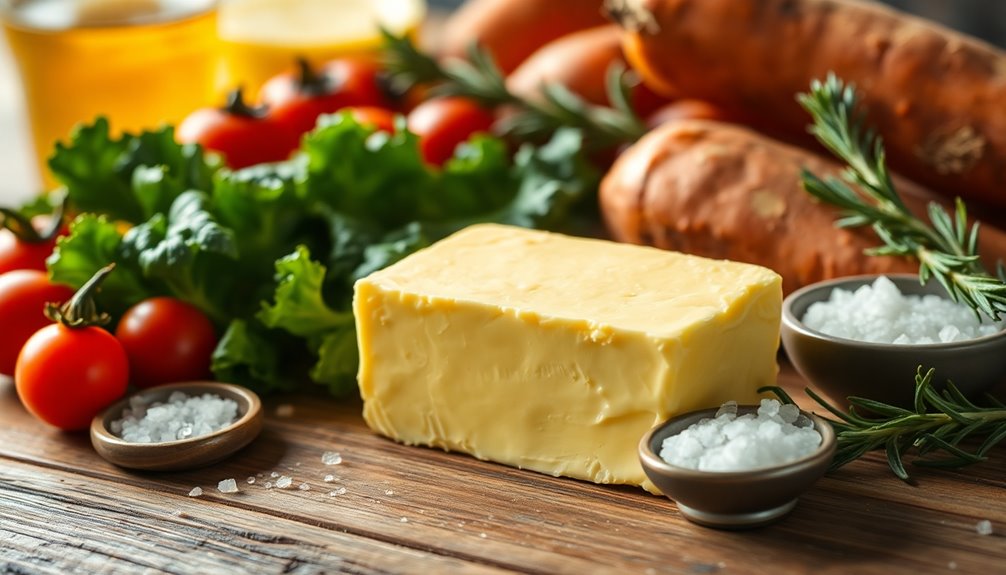
Understanding the differences between butter and ghee can help you make informed choices about how to incorporate these fats into your Paleo diet. Start by choosing high-quality grass-fed butter, which is richer in omega-3 fatty acids and CLA compared to conventional butter. This choice also supports sustainable farming. Always check that your butter is free from additives and preservatives.
Use butter in moderation. Think of it as a flavor enhancer rather than your main fat source. You can add small amounts to sauté vegetables or finish off dishes, balancing it with healthier fats like olive or avocado oil. Avoid overconsumption by monitoring how your body reacts and adjusting your intake accordingly. Healthy fats are essential for hormone production and overall health, so consider incorporating them alongside your butter use.
Incorporate butter creatively. Use it in baking with almond or coconut flour to add moisture and flavor. Blend it into smoothies or sauces for an extra nutritional boost. You can also enhance the taste of cooked meats and veggies by adding butter during cooking.
Finally, maintain your Paleo principles by tracking your butter intake and ensuring it complements a diverse, balanced meal plan. Stick to one to two thumb-size portions per meal to keep everything in check.
Health Implications of Butter
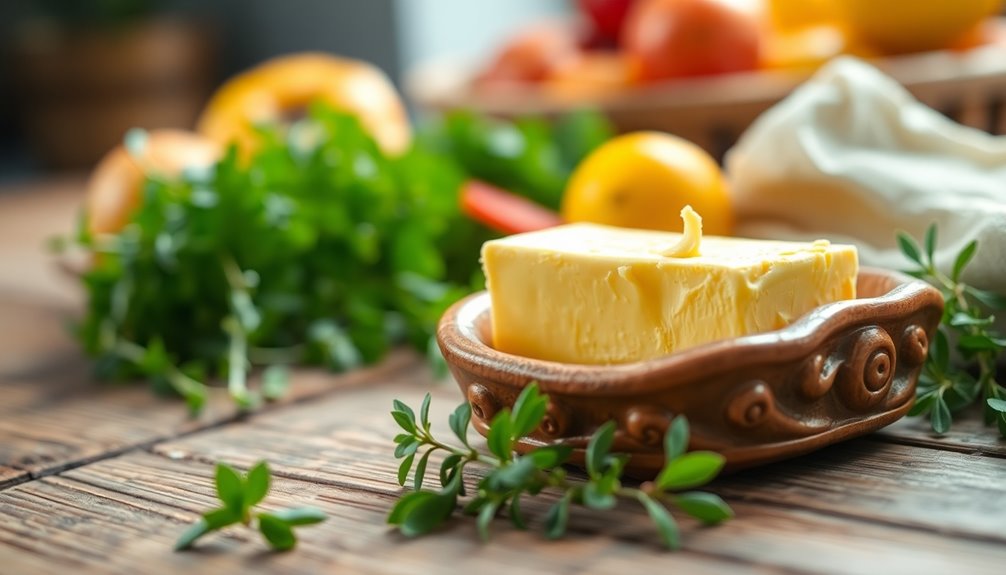
When considering the health implications of butter, it's crucial to balance its potential benefits against the risks it poses.
On the positive side, butter is rich in vitamins A, D, and E, which support eye, bone, and skin health. The beta-carotene found in butter may even lower the risk of certain cancers and help slow vision loss. Additionally, consuming high-quality fats can be beneficial for overall health when included in moderation. Butter's creamy texture is influenced by the emulsification process during churning, which can enhance its enjoyment in various dishes. Furthermore, integrating herbal alternatives for botox-like effects into your diet can complement the skin health benefits of butter. Butter's versatility as a cooking ingredient allows it to enhance the flavor of many dishes, making it a staple in various cuisines.
However, butter also contains high levels of saturated and trans fats, which can elevate "bad" cholesterol and lower "good" cholesterol, increasing your heart disease risk. The American Heart Association suggests limiting saturated fat intake to about 5% of daily calories, highlighting the need for caution. Additionally, butter's higher saturated fat content compared to other spreads can further exacerbate heart health concerns.
Butter's impact on gut health can vary, as it lacks fiber and polyphenols essential for gut bacteria. High-quality fats may benefit gut health better than low-quality ones found in some butter.
Additionally, with about 102 calories per tablespoon, using butter can complicate weight management, especially if consumed excessively.
Individual responses to butter differ, so it's essential to listen to your body and consider how it fits into your overall diet. Balancing the benefits and risks will help you make informed choices about butter in your Paleo diet.
Paleo-Friendly Butter Substitutes
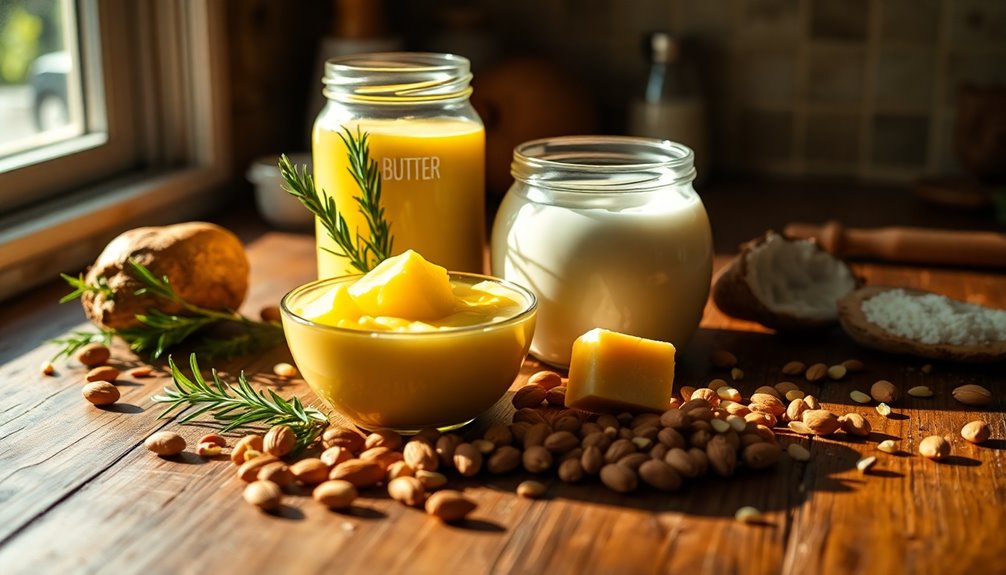
If you're looking for butter alternatives that fit into a Paleo diet, there are several delicious options to consider.
First up is coconut oil, which is high in healthy saturated fats and works well in both sweet and savory dishes. You can use it for baking, sautéing, or even as a spread on toast. Just remember, it solidifies at cooler temperatures, so keep your ingredients at room temperature for baking. Additionally, healthy fats from coconut oil are essential for energy and absorption of fat-soluble vitamins in the Paleo diet.
Another great choice is ghee, which is clarified butter with milk solids removed. Its rich, nutty flavor and high smoke point make it perfect for high-heat cooking like stir-frying or searing meat. You can easily substitute it for butter in a 1:1 ratio in most recipes.
Don't overlook avocado! Packed with monounsaturated fats, it can be mashed for spreads or added to smoothies. Plus, it's a great butter substitute in baking and adds a creamy texture to dressings or marinades.
Lastly, explore options like dairy-free yogurts, nut-based cheeses, or even make your own dairy-free butter using coconut milk and oils. They all provide tasty, creamy alternatives while keeping your Paleo diet intact.
Frequently Asked Questions
Can I Use Butter in Moderation on a Paleo Diet?
You can use butter in moderation on a Paleo diet, especially if you're following a more relaxed approach.
High-quality, grass-fed butter offers beneficial nutrients like vitamins A, E, and K2. Just be mindful of your individual tolerance and dietary goals.
Consider butter as a flavor enhancer rather than your main fat source, and balance it with other healthy fats. Listening to your body will help you find the right amount for you.
Is Clarified Butter the Same as Ghee?
No, clarified butter and ghee aren't the same, even though they're similar.
Clarified butter is made by melting butter and straining out the milk solids, while ghee is cooked longer until the milk solids brown and develop a nuttier flavor.
Both have high smoke points and are great for cooking, but ghee has a richer aroma and is completely free of dairy components, making it suitable for those sensitive to lactose.
What Are the Best Brands for Grass-Fed Butter?
When searching for the best brands of grass-fed butter, consider Kerrygold for its rich flavor and nutritional benefits.
Primal Pastures offers high-quality butter from pasture-raised cows, focusing on regenerative farming.
Vital Farms provides butter packed with anti-inflammatory properties and healthy fats.
Finally, Straus Family Creamery emphasizes sustainability and supports local farmers.
Each brand brings unique qualities, so you can choose based on your taste preferences and health goals.
Can Butter Be Part of a Ketogenic Diet?
Yes, butter can definitely be part of your ketogenic diet.
It's low in carbs and high in healthy fats, making it a great fit for your daily macro goals. With just 0.02 grams of carbs per tablespoon, it won't kick you out of ketosis.
Plus, it's rich in vitamins and beneficial compounds that can enhance your health.
Just be mindful of your overall calorie intake to avoid hindering your weight loss progress.
How Does Butter Affect Weight Loss on Paleo?
Butter can impact your weight loss on a Paleo diet in several ways. Its high calorie and saturated fat content may lead to unintended weight gain if you don't consume it in moderation.
While it contains beneficial nutrients, the potential for dairy intolerance and the presence of growth hormones could hinder your progress.
If you choose to include butter, focus on portion control and consider alternatives like ghee that may be easier on your system.
Conclusion
In conclusion, whether you can enjoy butter on a Paleo diet depends on your personal approach and tolerance. While traditional butter may not fit all Paleo guidelines, ghee offers a fantastic alternative that's more aligned with the lifestyle. Remember to consider your health goals and how butter affects your body. Experiment with various Paleo-friendly substitutes to find what works best for you, ensuring your meals stay delicious and satisfying while adhering to the principles of the diet.
